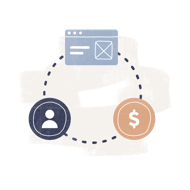Advertiser & Editorial Disclosure
Becoming a landlord can potentially be a smart investment, especially in our current national climate. The number of Americans who rent their homes is at an all-time high, according to the National Multifamily Housing Council and the National Apartment Association. But the current supply of apartments and rental homes isn’t keeping up with the demand.
When the process goes well, buying a rental property can generate a passive income stream that can help you now and in retirement. A rental property may also diversify your investment portfolio and create an asset that grows in value over time.
Yet even if you find the perfect investment opportunity, securing a rental property loan can sometimes be a challenge. Thankfully, you have options. Below we’ll cover a few of the most common types of investment property loans along with insights into how they work.
The Difference Between Rental Property Loans and Conventional Home Loans
If you’ve taken out a mortgage for your primary residence in the past, you’ll find similarities in the process whenever you try to finance a non-owner occupied property. With an investment loan, you’ll still need to fill out an application, verify your income and assets, and the lender will check your credit reports and scores.
But there are also some key differences you may experience when you apply for your first rental property loan.
1. Lenders are more stringent.
Loans for investment properties are inherently more risky for lenders than standard, owner-occupied mortgages. The probability of late payments and default on rental property loans are higher. When money gets tight, real estate investment loans usually aren’t at the top of someone’s priority list.
Imagine the following scenario. You’re a homeowner, and you owe the bank a mortgage on your primary residence. You also own a rental home, and you owe a mortgage on that property as well.
Now, imagine something changes in your financial picture. Your income decreases and your tenant stops making his rent payments on time. All of a sudden, you can’t afford to make the mortgage payments on both your primary residence and your rental property. So which mortgage do you choose to keep current? Many people will choose their primary residence.
Because of the increased risk involved with investment property loans, lenders may require you to jump through more hoops before they approve your mortgage application. For example, you might need:
- A larger down payment (commonly 20% or higher)
- More cash reserves (often six months per existing mortgage plus the new mortgage)
- Sufficient income to cover existing debts and a new mortgage (debt-to-income ratio, aka DTI, should ideally be at or below 36% for the best rates and terms)
- A higher credit score to secure better rates and terms (often 720 and up)
2. Interest rates may be higher.
Not only may it be tougher to qualify for a rental property loan than for a mortgage on a primary residence, but it’s generally more expensive too. Again, the pricing of your mortgage is directly related to the amount of risk the lender believes its taking.
Even borrowers with excellent credit scores may pay a higher interest rate on a rental property loan than they would on a traditional mortgage. How much higher? Rates can vary widely from lender to lender. It’s common to see interest rates between .5% and .875% higher on real estate investment mortgages compared with standard residential mortgages.
For example, say you qualify for a 30-year fixed-rate mortgage at 3.5% interest for your primary residence. In this scenario, you might expect to pay around 4%–4.4% for a similar investment property mortgage.
3. Qualifying property types may be different.
According to Quicken Loans, an investment property typically needs to fit into one of the following categories:
- Condo
- House
- Single-Family Unit
- Multi-Family Unit
In general, you’ll need to stick with one to four-unit properties when you apply for a rental property loan. If you want to buy an investment property with more than four units, you might need to consider a commercial residential loan or an apartment loan as an alternative. FHA multi-family financing might also be a good fit.
It’s worth noting that if you purchase a multi-family unit and plan to live in one unit yourself, you might be able to take out a primary mortgage on the property. For owner-occupied properties, you may be able to use an FHA loan or VA loan to finance your purchase. A conventional mortgage could also be worth considering. Any of these three options might translate to a lower interest rate and better terms on your mortgage. Loan-to-value ratio (LTV), down payment requirements, and DTI requirements may be less strict in this scenario as well.
4. Private mortgage insurance doesn’t apply to many rental property loans.
On the positive side, you often won’t be charged private mortgage insurance (PMI) for rental property loans. PMI generally doesn’t apply to investment property loans when you’re putting down 20% or more to secure a conventional mortgage. But, the CFPB warns, if your down payment is less than 20%, PMI might raise the cost of your loan.
PMI is a type of insurance that protects the lender in the event you borrow money but eventually default on your payments. Although PMI isn’t designed to protect you, you’re the one who pays for this insurance when it comes to conventional financing. The monthly insurance premium is usually added to your mortgage payment.
You could potentially save a lot by securing a conventional mortgage with no PMI for your rental property. PMI adds an average fee of 0.5% and 1% of your loan amount per year. So, on a 250,000 rental property, you might pay an extra $2,500 per year — potentially adding $208 to your monthly mortgage payment. Providing a 20% downpayment (as is the norm with many rental property loans) would likely help you avoid the extra cost of mortgage insurance.
Funding Options for Rental Property Loans
Like mortgages designed for the purchase of owner-occupied residences, you have more than one option when you’re shopping for the perfect investment property loan. This is true whether you’re taking out a loan for a new rental property or hoping to refinance an existing investment property loan.
Below are three types of loans for non-owner occupied real estate loans to consider.
Conventional Financing
Conventional loans, also called conforming loans, are mortgages that are guaranteed by a government-sponsored enterprise (GSE) — namely Fannie Mae or Freddie Mac. Conventional loans often feature the lowest interest rates and fees available when you want to finance an investment property that you don’t plan to live in personally.
You’ll need to supply a down payment of at least 20% on conventional loans to avoid paying mortgage insurance. Fannie Mae and Freddie Mac guidelines allow real estate investors up to 10 mortgages (restrictions apply). However, many lenders won’t approve you for an additional mortgage loan once you already have four of them.
Blanket Mortgage
Another way to potentially secure financing as a real estate investor is to consider cross collateralization. If you want to take out multiple rental property loans at once, a cross-collateralized blanket mortgage might help.
With a blanket mortgage, you finance multiple investment properties under a single loan. Developers commonly use blanket mortgages, for example, when they want to purchase a large property and build multiple homes. Blanket mortgages often appeal to house flippers as well.
If you’re considering a blanket mortgage, be aware of the following benefits and risks:
- The properties serve as collateral for each other. This may reduce the bank’s risk while increasing yours. If you default on the loan, you could lose multiple properties.
- Ideally, you should look for a blanket mortgage with a release clause. This may allow you to sell individual properties separately when you’re ready to do so.
- You might be able to refinance existing properties you own under a blanket mortgage. This could serve as a cash-out refinance if you need to free up funds for other investments.
- Blanket mortgages are usually short-term loans. Often, you’ll need to pay off the loan or refinance within one to five years.
Portfolio Loan
While conventional loans are sold to investors and therefore have to meet GSE guidelines, portfolio loans are held by the lender who issues them. As a result, portfolio lenders approve or deny your mortgage application based on its own approval criteria, and it’s often not as strict.
A portfolio loan might be a good fit if you’re not able to qualify for a conventional mortgage to buy an investment property. However, because the loan guidelines are looser, there’s usually a cost. Translation: You might have to pay more for a portfolio loan.
In addition to potentially higher interest rates, there may be other downsides to using a portfolio loan to finance your rental property, such as:
- Balloon Payments
- Prepayment Penalties
- Higher Fees (Origination, Closing Costs, etc.)
If you’re considering a portfolio loan, be sure to carefully review the terms offered. It’s also wise to compare rates and fees from several lenders to help you find the best deal available.
How to Get Lower Rental Property Mortgage Rates
Because rental property loans involve more risk for issuing lenders, interest rates for this type of financing can sometimes be much higher than traditional mortgage rates. If you’re hoping to secure a lower interest rate on your rental property mortgage, these ideas might help. To figure out how much financing you can take on and still maintain positive cash flow, run the numbers in a rental property calculator or spreadsheet.
- Put up a bigger down payment. Many lenders require a down payment of 20% on a rental property loan, and some require down payments as high as 25%. You might find lenders that will accept lower down payment amounts. However, smaller down payments often lead to higher interest rates on your mortgage.
- Improve your credit score. Credit scores aren’t just a significant factor in your ability to qualify for a rental property loan. Your credit also influences the interest rate you’ll pay for financing. If you want a chance to secure the best rates available from lenders, you should aim for a credit score of 760 or higher. (Note: Some lenders may extend their lowest rates at the 720 credit score threshold.)
- Shop around. Don’t underestimate the importance of shopping around for the best deal when you’re financing an investment property purchase. Research from Freddie Mac reveals that comparing five loan quotes could save borrowers around $3,000 on average.
Alternative Rental Property Financing
If you can’t find the loan you need to purchase a rental property, there is one other option you might consider — seller financing. With seller financing, the person you’re buying the property from acts as the lender, at least initially. Often, you may have a few years (perhaps 3-5), after which you’ll owe a balloon payment of the remaining balance to the seller. By this point, you would need to have the cash to pay off the property or another form of financing lined up.
If you’re hoping to buy a rental property with no money down, this might be something you can negotiate with the seller. Just keep in mind that no money down may be a big ask, depending upon the situation. Many sellers may turn down your request.
Preparing for a big business purchase often includes preparing for a loan application. You can put yourself in the best position possible with Nav’s Business Loan Builder plan. You’ll be able to see where you stand before diving into an application, and even access your FICO SBSS score, which lenders will check if you choose to apply for an SBA 504 loan.
Final Word on Rental Property Loans
Buying and renting out the right investment property could help you to establish a passive income stream and diversify your investments. According to Zillow, home values in the U.S. increased by 4.8% in the past year and are predicted to keep rising into 2020.
But it’s important to understand that investment properties are also a gamble. You shouldn’t consider the potential financial upside of investment properties without also acknowledging the risk.
Also, don’t rush into a decision without doing your homework. Before you make any big commitments, you should thoroughly research the rental property you want to buy and the local real estate market. Then you’ll be ready to shop for the best loan program to use for the purchase.
This article was originally written on October 31, 2019 and updated on February 21, 2020.




Have at it! We'd love to hear from you and encourage a lively discussion among our users. Please help us keep our site clean and protect yourself. Refrain from posting overtly promotional content, and avoid disclosing personal information such as bank account or phone numbers.
Reviews Disclosure: The responses below are not provided or commissioned by the credit card, financing and service companies that appear on this site. Responses have not been reviewed, approved or otherwise endorsed by the credit card, financing and service companies and it is not their responsibility to ensure all posts and/or questions are answered.